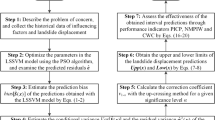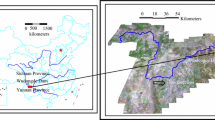Abstract
Data-based dam monitoring model can predict dam behavior and provide scientific basis for risk assessment and decision-making of dam engineering. Traditional dam safety monitoring models established by multiple regression, stepwise regression, gray theory, and other statistics-based methods have poor robustness and generalization. For this reason, an optimized support-vector machine (SVM) whose novelty lies in simple implementation, self-adaptive hyperparameter selection with aid of adaptive position particle swarm optimization (APPSO), and retention of influence factor combination is presented for constructing the dam safety monitoring model. A real-world concrete gravity dam engineering is used to verify the presented approach, and the results indicate the monitoring model built by APPSO–SVM outperforms benchmark models in terms of fitting and prediction accuracy.






Similar content being viewed by others
Data availability
Enquiries about data availability should be directed to the authors.
References
Asanga R, Saman KH, Harry CW (2004) Self-organizing hierarchical particle swarm optimizer with time-varying acceleration coefficients. IEEE Trans Evol Comput 8(3):240–255
Chen J (2001) Short-term prediction of observation data based on Lyapunov exponent. J Hydraul Eng 32(9):64–67
Cheng L, Zheng DJ (2013) Two online dam safety monitoring models based on the process of extracting environmental effect. Adv Eng Softw 57(1):48–56
Liu HW, Lin YX, Qi MJ et al (2005) Improved particle swarm optimization algorithm for solving constrained optimization problems. J Northeast Pet Univ 29(4):73–75
Mata J (2011) Interpretation of concrete dam behaviour with artificial neural network and multiple linear regression models. Eng Struct 33(3):903–910
Oh HS, Kim D, Lee Y (2009) Cross-validated wavelet shrinkage. Comput Stat 24(3):497–512
Ranković V, Grujović N, Divac D et al (2012) Modelling of dam behaviour based on neuro-fuzzy identification. Eng Struct 35:107–113
Salazar F, Toledo MA, Oñate E et al (2015) An empirical comparison of machine learning techniques for dam behavior modeling. Struct Saf 56:9–17
Salazar F, Moran R, Toledo MÁ et al (2017) Data-based models for the prediction of dam behavior: A review and some methodological considerations. Arch Comput Methods Eng 24(1):1–21
Stojanovic B, Milivojevic M, Ivanovic M et al (2013) Adaptive system for dam behavior modeling based on linear regression and genetic algorithms. Adv Eng Softw 65:182–190
Su HZ, Wu ZR, Wen ZP (2007) Identification model for dam behavior based on wavelet network. Comput-Aid Civ Infrastruct Eng 22(6):438–448
Su HZ, Chen ZX, Wen ZP (2016a) Performance improvement method of support vector machine-based model monitoring dam safety. Struct Control Health Monit 23(2):252–266
Su HZ, Wen ZP, Chen ZX et al (2016b) Dam safety prediction model considering chaotic characteristics in prototype monitoring data series. Struct Health Monit 15(6):639–649
Su HZ, Wen ZP, Sun XR et al (2017) Rough set-support vector machine-based real-time monitoring model of safety status during dangerous dam reinforcement. Int J Damage Mech 26(4):501–522
Su HZ, Li X, Yang BB et al (2018a) Wavelet support vector machine-based prediction model of dam deformation. Mech Syst Signal Process 110:412–427
Su HZ, Chen J, Wen ZP et al (2018b) Wavelet-fractal diagnosis model and its criterion for concrete dam crack status. Trans Inst Meas Control 40(6):1846–1853
Su HZ, Ren J, Wen ZP (2019) An approach using Dempster-Shafer evidence theory to fuse multi-source observations for dam safety estimation. Soft Comput 23(14):5633–5644
Xu C, Yue D, Deng C (2011) Hybrid GA/SIMPLS as alternative regression model in dam deformation analysis. Eng Appl Artif Intell 25(3):468–475
Yang LF, Su HZ, Wen ZP (2019) Improved PLS and PSO methods-based back analysis for elastic modulus of dam. Adv Eng Softw 131:205–216
Funding
This research has been partially supported by National Natural Science Foundation of China (SN: 51979093, 51739003), the National Key Research and Development Program of China (SN: 2019YFC1510801, 2018YFC0407101), Open Foundation of State Key Laboratory of Hydrology-Water Resources and Hydraulic Engineering (SN: 520003812), the Fundamental Research Funds for the Central Universities (Grant No. 2015B25414).
Author information
Authors and Affiliations
Corresponding author
Ethics declarations
Conflict of interest
The authors declare that they have no conflict of interest. Research does not involve human participants and/or animals.
Additional information
Publisher's Note
Springer Nature remains neutral with regard to jurisdictional claims in published maps and institutional affiliations.
Rights and permissions
Springer Nature or its licensor holds exclusive rights to this article under a publishing agreement with the author(s) or other rightsholder(s); author self-archiving of the accepted manuscript version of this article is solely governed by the terms of such publishing agreement and applicable law.
About this article
Cite this article
Wen, Z., Fan, Z. & Su, H. An APPSO–SVM approach building the monitoring model of dam safety. Soft Comput 26, 11451–11459 (2022). https://doi.org/10.1007/s00500-022-07422-z
Accepted:
Published:
Issue Date:
DOI: https://doi.org/10.1007/s00500-022-07422-z




